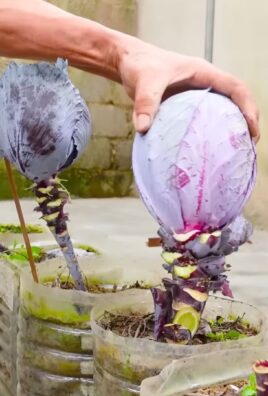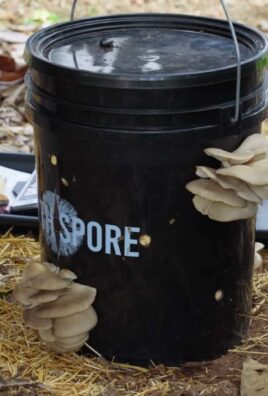Grow Watermelon Indoors Easily? Absolutely! Imagine biting into a juicy, homegrown watermelon in the dead of winter, a taste of summer sunshine when you need it most. Sounds like a dream, right? Well, it doesn’t have to be! For centuries, humans have been finding innovative ways to cultivate plants in less-than-ideal conditions. From ancient Roman greenhouses to modern hydroponics, the desire to nurture life indoors is deeply ingrained in our history.
But why should you learn to grow watermelon indoors easily? Let’s face it, not everyone has a sprawling backyard or the perfect climate for these thirsty giants. Maybe you live in an apartment, or perhaps your growing season is simply too short. Whatever the reason, this DIY guide is your ticket to enjoying the sweet reward of homegrown watermelon, regardless of your limitations. We’ll break down the process into simple, manageable steps, revealing insider tricks and hacks that will have you harvesting your own watermelons in no time. Get ready to unleash your inner gardener and bring a taste of summer indoors!

Growing Watermelon Indoors: A Sweet Summer Treat, All Year Round!
Okay, so you’re dreaming of juicy, homegrown watermelon but don’t have a sprawling garden? No problem! I’m going to walk you through how to grow watermelons indoors. It might seem a little unconventional, but with the right setup and a little patience, you can absolutely enjoy the taste of summer, even when it’s snowing outside.
Choosing the Right Watermelon Variety
First things first, not all watermelons are created equal when it comes to indoor growing. We need to think small! Big, sprawling varieties like ‘Charleston Gray’ are going to be a nightmare indoors. Instead, opt for these compact, bush-type varieties:
* ‘Sugar Baby’: This is a classic, small watermelon that matures quickly. It’s a reliable choice for beginners.
* ‘Bush Sugar Baby’: As the name suggests, this is an even more compact version of ‘Sugar Baby,’ perfect for containers.
* ‘Golden Midget’: A unique variety with yellow skin and pink flesh. It’s small and matures early.
* ‘Tiger Baby’: A small, striped watermelon that’s known for its sweet flavor.
These varieties are much more manageable in a container and will give you a better chance of success.
Setting Up Your Indoor Watermelon Garden
Before we even think about planting, let’s get our indoor garden ready. Watermelons need a few key things to thrive:
* Large Containers: Watermelons have extensive root systems. You’ll need a container that’s at least 20 inches in diameter and 18 inches deep. A 25-gallon container is even better!
* Well-Draining Soil: Watermelons hate soggy feet. Use a high-quality potting mix that’s well-draining. You can amend it with perlite or vermiculite to improve drainage. I like to mix equal parts potting soil, compost, and perlite.
* Strong Support System: Even bush varieties can get a little unruly. A sturdy trellis or tomato cage will help support the vines and keep the watermelons off the ground. This is especially important as the fruits get heavier.
* Grow Lights (Essential!): Unless you have a south-facing window that gets at least 6-8 hours of direct sunlight, you’ll need grow lights. Watermelons need a lot of light to produce fruit. Full-spectrum LED grow lights are a great option because they’re energy-efficient and provide the right kind of light for plant growth.
* Pollination Tools: Since we’re growing indoors, we’ll need to play the role of the bees. A small, soft paintbrush or cotton swab will do the trick.
Planting Your Watermelon Seeds
Now for the fun part! Let’s get those seeds in the soil.
1. Start Seeds Indoors (Recommended): While you can direct sow watermelon seeds, starting them indoors gives them a head start. About 3-4 weeks before your last expected frost (or whenever you want to start growing!), sow the seeds in small pots filled with seed-starting mix. Plant the seeds about 1 inch deep.
2. Keep the Soil Warm: Watermelon seeds germinate best in warm soil (around 80-85°F). You can use a heat mat to help speed up germination.
3. Water Gently: Keep the soil consistently moist, but not soggy. Use a spray bottle to gently water the seeds.
4. Provide Light: Once the seedlings emerge, place them under grow lights or in a sunny window.
5. Transplant Seedlings: Once the seedlings have a few sets of true leaves (usually after 2-3 weeks), it’s time to transplant them into their large containers. Gently remove the seedlings from their small pots and plant them in the center of the container.
Caring for Your Indoor Watermelon Plants
Okay, so you’ve got your watermelon plants growing. Now it’s time to give them the TLC they need to thrive.
1. Watering: Watermelons need consistent moisture, especially when they’re fruiting. Water deeply whenever the top inch of soil feels dry to the touch. Avoid overwatering, as this can lead to root rot.
2. Fertilizing: Watermelons are heavy feeders. Feed them regularly with a balanced fertilizer (10-10-10) every 2-3 weeks. Once the plants start to flower, switch to a fertilizer that’s higher in phosphorus and potassium (like 5-10-10) to encourage fruit production. I like to use a liquid fertilizer diluted to half strength.
3. Pruning: Prune away any suckers (small shoots that grow from the base of the plant) to encourage the plant to focus its energy on fruit production. You can also prune away some of the leaves to improve air circulation and light penetration.
4. Pollination (This is Crucial!): Since we don’t have bees buzzing around indoors, we need to hand-pollinate the flowers. Watermelons have separate male and female flowers. The female flowers have a small, immature watermelon at the base of the flower.
* Identify Male and Female Flowers: Male flowers usually appear first. They have a long, thin stem and no fruit at the base. Female flowers have a small, immature watermelon at the base.
* Pollinate in the Morning: The best time to pollinate is in the morning, when the flowers are fully open.
* Use a Paintbrush or Cotton Swab: Gently collect pollen from the male flower with a paintbrush or cotton swab.
* Transfer Pollen to Female Flower: Gently transfer the pollen to the stigma (the sticky part in the center) of the female flower.
* Repeat: Repeat this process for all the female flowers that open.
* Mark Pollinated Flowers: Use a small piece of ribbon or tape to mark the pollinated flowers. This will help you keep track of which ones you’ve already pollinated.
5. Support the Fruit: As the watermelons grow, they can get quite heavy. If you’re using a trellis, make sure the vines are securely attached. You may also need to provide additional support for the fruit itself. You can use slings made from pantyhose or netting to support the watermelons.
6. Pest and Disease Control: Keep an eye out for pests like aphids, spider mites, and whiteflies. You can control these pests with insecticidal soap or neem oil. Watermelons can also be susceptible to fungal diseases like powdery mildew. Improve air circulation and avoid overwatering to prevent these diseases. If you do get powdery mildew, you can treat it with a fungicide.
Harvesting Your Indoor Watermelons
The moment we’ve all been waiting for! Harvesting your homegrown watermelons.
1. Check the Tendril: The tendril closest to the watermelon stem will turn brown and dry when the watermelon is ripe.
2. Thump Test: Give the watermelon a gentle thump. A ripe watermelon will sound hollow.
3. Ground Spot: The spot where the watermelon rests on the ground (or in your sling) will turn from white to yellow.
4. Days to Maturity: Check the seed packet for the days to maturity. This will give you a general idea of when to expect your watermelons to be ripe.
5. Cut the Stem: Once the watermelon is ripe, use a sharp knife to cut the stem close to the fruit.
Troubleshooting Common Problems
Even with the best care, you might encounter a few problems along the way. Here are some common issues and how to fix them:
* Yellowing Leaves: This could be a sign of overwatering, underwatering, or nutrient deficiency. Check the soil moisture and adjust your watering accordingly. Fertilize the plants with a balanced fertilizer.
* Flowers Dropping Off: This is often caused by poor pollination. Make sure you’re hand-pollinating the flowers properly.
* Small, Misshapen Fruit: This could be caused by poor pollination or nutrient deficiency. Make sure you’re hand-pollinating the flowers properly and fertilizing the plants regularly.
* Pests: Inspect your plants regularly for pests. Treat any infestations with insecticidal soap or neem oil.
* Powdery Mildew: Improve air circulation and avoid overwatering to prevent powdery mildew. If you do get powdery mildew, you can treat it with a fungicide.
Enjoying Your Homegrown Watermelon
Congratulations! You’ve successfully grown watermelons indoors. Now it’s time to enjoy the fruits (literally!) of your labor. Slice up your homegrown watermelon and savor the sweet, juicy flavor. You can also use it in smoothies, salads, or desserts.
Growing watermelons indoors takes a little effort, but it’s definitely worth it. There’s nothing quite like the taste of a homegrown watermelon,

Conclusion
So, there you have it! Growing watermelon indoors might seem like a daunting task, reserved for seasoned gardeners with acres of land, but with a little know-how and dedication, you can absolutely cultivate these juicy delights right in your own home. This DIY trick isn’t just about saving money; it’s about experiencing the sheer joy of nurturing life from seed to fruit, witnessing the miracle of nature unfold before your eyes, and enjoying the unparalleled flavor of a homegrown watermelon.
Why is this a must-try? Because it empowers you to control the growing environment, shielding your precious watermelons from unpredictable weather, pests, and diseases that often plague outdoor crops. Imagine biting into a perfectly ripe, sweet watermelon in the middle of winter – a taste of summer sunshine when you need it most! Plus, it’s a fantastic learning experience for both adults and children, fostering a deeper appreciation for the food we eat and the effort it takes to produce it.
But don’t stop there! Feel free to experiment with different watermelon varieties. Miniature watermelons like ‘Sugar Baby’ are particularly well-suited for indoor growing due to their smaller size and shorter growing season. You can also explore different training techniques, such as vertical gardening, to maximize space and encourage healthy vine growth. Consider using self-watering containers to simplify watering and ensure consistent moisture levels. And if you’re feeling adventurous, try grafting your watermelon seedlings onto more vigorous rootstock for increased disease resistance and productivity.
Remember, success in indoor watermelon growing hinges on providing adequate light, warmth, and pollination. Invest in a good quality grow light, maintain a consistent temperature, and hand-pollinate your female flowers to ensure fruit set. Don’t be discouraged if your first attempt isn’t perfect. Gardening is a journey of learning and experimentation. Each failure is simply a stepping stone to future success.
We wholeheartedly encourage you to give this DIY trick a try. Embrace the challenge, get your hands dirty, and experience the satisfaction of growing your own watermelons indoors. And most importantly, share your experiences with us! We’d love to hear about your successes, your challenges, and any tips or tricks you discover along the way. Post photos of your indoor watermelon garden, share your favorite recipes using your homegrown watermelons, and let’s create a community of indoor watermelon enthusiasts! Your insights could inspire others to embark on their own indoor gardening adventures. So, go ahead, take the plunge, and discover the magic of growing watermelon indoors. You won’t regret it! This method of growing watermelon indoors easily will bring you joy.
Frequently Asked Questions (FAQ)
1. What are the best watermelon varieties to grow indoors?
While you can technically grow any watermelon variety indoors, smaller, bush-type varieties are generally more suitable due to space constraints. ‘Sugar Baby’ is a popular choice because it produces relatively small fruits and has a shorter growing season. Other good options include ‘Bush Sugar Baby,’ ‘Golden Midget,’ and ‘Tiger Baby.’ These varieties are bred to be more compact and manageable, making them ideal for indoor cultivation. Consider the size of your growing space and the length of the growing season when selecting a variety.
2. How much light do indoor watermelons need?
Watermelons are sun-loving plants and require a significant amount of light to thrive. Ideally, they need at least 6-8 hours of direct sunlight per day. However, since natural sunlight can be limited indoors, especially during winter months, you’ll need to supplement with artificial grow lights. LED grow lights are a great option because they are energy-efficient and provide the full spectrum of light that plants need for photosynthesis. Choose a grow light with a high PAR (Photosynthetic Active Radiation) value to ensure that your watermelons receive sufficient light intensity. Position the grow light close to the plants, but not so close that it burns the leaves. Adjust the height of the light as the plants grow to maintain optimal light exposure.
3. How do I pollinate watermelons indoors?
Watermelons are not self-pollinating, meaning they require pollination from another watermelon flower to produce fruit. Outdoors, bees and other insects typically handle this task. Indoors, you’ll need to hand-pollinate the flowers yourself. To do this, use a small paintbrush or cotton swab to collect pollen from the male flowers (those with a straight stem behind the flower) and transfer it to the female flowers (those with a small, immature watermelon behind the flower). It’s best to pollinate in the morning when the flowers are freshly opened. Repeat the process for several days to ensure successful pollination. You can identify female flowers by the small, immature fruit (a tiny watermelon) located at the base of the flower.
4. What type of soil is best for growing watermelons indoors?
Watermelons need well-draining soil that is rich in organic matter. A good potting mix for watermelons should be light and airy, allowing for good root development. You can create your own potting mix by combining equal parts of peat moss, perlite, and vermiculite. Alternatively, you can purchase a commercially available potting mix specifically formulated for vegetables. Avoid using garden soil, as it can be too heavy and may contain pests or diseases. Amend the potting mix with compost or other organic matter to improve its fertility and water-holding capacity.
5. How often should I water my indoor watermelons?
Watermelons need consistent moisture, but they don’t like to sit in soggy soil. Water deeply whenever the top inch of soil feels dry to the touch. Avoid overwatering, as this can lead to root rot. The frequency of watering will depend on several factors, including the size of the pot, the temperature, and the humidity. Check the soil moisture regularly and adjust your watering schedule accordingly. Consider using a moisture meter to get an accurate reading of the soil moisture level.
6. What kind of fertilizer do watermelons need?
Watermelons are heavy feeders and require regular fertilization to support their growth and fruit production. Use a balanced fertilizer with a ratio of 10-10-10 or 14-14-14 during the early stages of growth. Once the plants start to flower, switch to a fertilizer with a higher phosphorus content (e.g., 5-10-5) to promote fruit development. Follow the instructions on the fertilizer label carefully and avoid over-fertilizing, as this can damage the plants. You can also supplement with organic fertilizers, such as compost tea or fish emulsion.
7. How do I deal with pests and diseases on my indoor watermelons?
Indoor watermelons are generally less susceptible to pests and diseases than outdoor plants, but they can still be affected. Common pests include aphids, spider mites, and whiteflies. To prevent infestations, inspect your plants regularly and take action at the first sign of trouble. You can control pests by spraying the plants with insecticidal soap or neem oil. For diseases, ensure good air circulation and avoid overwatering. If you notice any signs of disease, such as leaf spots or powdery mildew, remove the affected leaves and treat the plants with a fungicide.
8. How long does it take to grow a watermelon indoors?
The time it takes to grow a watermelon indoors depends on the variety, the growing conditions, and your level of care. Generally, it takes about 70-90 days from planting to harvest. Miniature watermelons tend to mature faster than larger varieties. Provide optimal growing conditions, including adequate light, warmth, and nutrients, to shorten the growing season. Be patient and monitor your plants closely. You’ll know your watermelon is ripe when the tendril closest to the fruit turns brown and dry, and the bottom of the watermelon turns yellow.
9. How do I know when my indoor watermelon is ripe?
Determining when a watermelon is ripe can be tricky, but there are a few telltale signs to look for. First, check the tendril closest to the fruit. If it’s brown and dry, that’s a good indication that the watermelon is ripe. Second, look at the bottom of the watermelon where it rests on the ground. This spot should turn from white to yellow. Finally, give the watermelon a gentle thump. A ripe watermelon will sound hollow. With practice, you’ll develop a knack for knowing when your indoor watermelons are perfectly ripe and ready to enjoy.
10. Can I grow watermelon indoors year-round?
Yes, with the right conditions, you can grow watermelon indoors year-round. The key is to provide consistent light, warmth, and humidity. Use grow lights to supplement natural sunlight during the winter months. Maintain a consistent temperature of 70-80°F (21-27°C) and a humidity level of 50-60%. You may need to adjust your watering and fertilization schedule depending on the season. By creating a controlled indoor environment, you can enjoy fresh, homegrown watermelons any time of year.





Leave a Comment